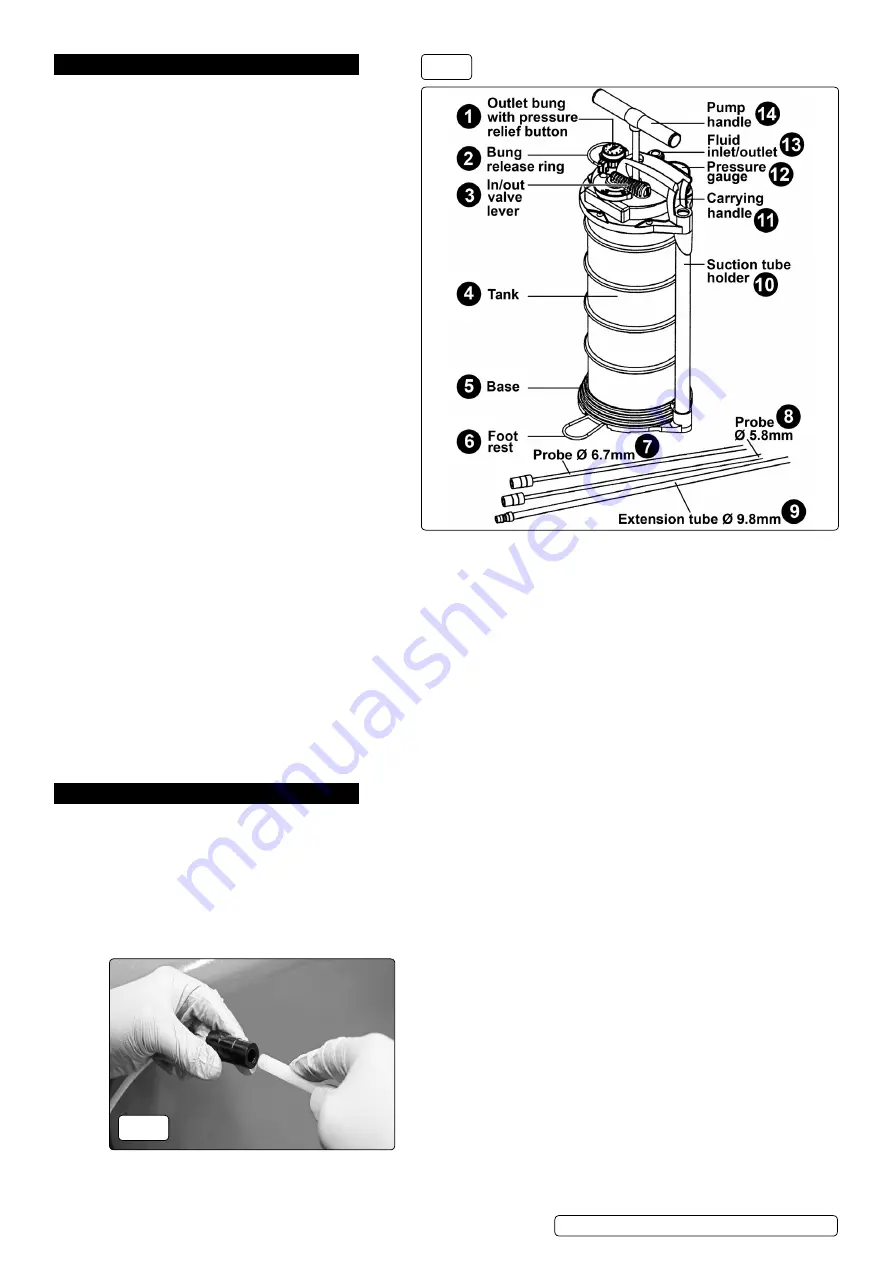
4. MAIN FEATUREs
Features
Refer to fig.1
4.1.
OUTLET BUNg
The outlet bung is inserted into a small
spout in the top of the unit which is used to manually
empty oil out of the tank. The bung has an integral
pressure relief button built into it. Press the button
downwards into the bung and hold it there until the
pressure has equalised.
4.2.
BUNg RELEAsE RINg
To remove the bung take hold of
the bung release ring and turn the bung anti-clockwise
until it stops. Pull upwards to remove the bung. To lock the
bung in place insert it into the spout and turn it clockwise
until it stops. The hooks on either side of the bung should
now be trapped under the flanges on either side of the
spout.
4.3.
IN/OUT VALVE LEVER
When the valve lever is moved
to the ‘In’ position, operating the pump handle creates
a vacuum, causing fluid to be sucked into the tank
via the probe/extension tube. When the valve lever
is moved to the ‘oUT’ position, operating the pump handle
pressurises the tank causing fluid to be expelled from the
tank.
4.4.
TANk
After the unit has been used the tank should not be
left in either a vacuum or pressurised state. Push in the
pressure relief button and hold it down until the pressure
has equalised.
4.5.
BAsE
The base should be placed on a smooth level
surface during operation.
4.6.
FOOTREsT
When extra stability is required during
pumping fold out the footrest from underneath the base.
4.7.
PROBE Ø6.7
This is the larger of the two probes provided and is intended for insertion into the dipstick tube of vehicles where an oil
change is required. The red plastic fitting on this tube is a push fit onto the extension tube.
4.8.
PROBE Ø5.8
This is the smaller of the two probes provided and is intended for insertion into the dipstick tube of vehicles where an oil
change is required. The black plastic fitting on this tube is a push fit onto the extension tube.
4.9.
EXTENsION TUBE Ø9.8
The fitting at one end of this tube fits directly into the Fluid inlet/outlet ‘13’. one of the probes will be a push fit
onto the other end of this tube.
4.10.
sUCTION TUBE hOLDER
The extension tube and the two probes can be stored here when not required.
4.11.
CARRYINg hANDLE
The pump handle should be in the down position to use the carrying handle.
4.12.
PREssURE gAUgE
The needle moves anti-clockwise from zero when a vacuum is created to suck fluid into the tank. The needle moves
clockwise from zero when the tank is pressurised to expel fluid from the tank. If the needle moves into the red zone the excess pressure
will be automatically released.
4.13.
FLUID INLET OUTLET
This fitting has a sliding sleeve which has to be pulled downwards before the fitting on the end of the extension
tube will go in.
4.14.
PUMP hANDLE
The pump handle should be moved up and down through its full stroke for most efficient operation of the pump. If the
pump handle locks up this means the tank is full. Press the pressure relief button to free the handle.
5. OPERATION
5.1.
sET UP FOR OIL ChANgE
NOTE:
ensure you read, understand and apply the Section 1 Safety Instructions and consult manufacturer’s workshop manual for any
specific procedures.
5.1.1.
ensure that the vehicle is level. Run the engine for approximately five minutes to ensure that the oil is warm. Switch off engine.
5.1.2.
Remove the oil dipstick from the engine.
5.1.3.
Insert the appropriate extracting probe into the dipstick tube making sure it reaches the bottom of the sump. Connect the extracting probe
to the extension tube using the black or red soft plastic adaptor. The tubes are a push fit into the adaptor (fig.2).
5.1.4.
Position the extractor close to the front or side of the vehicle. Plug the extension tube fitting into the fluid inlet/outlet fitting on top of the
extractor (see fig.1-13).
Original Language Version
© Jack Sealey limited
fig.2
fig.1
TP6905.V2, TP6906.V2 Issue:3 (3) 26/04/19





















